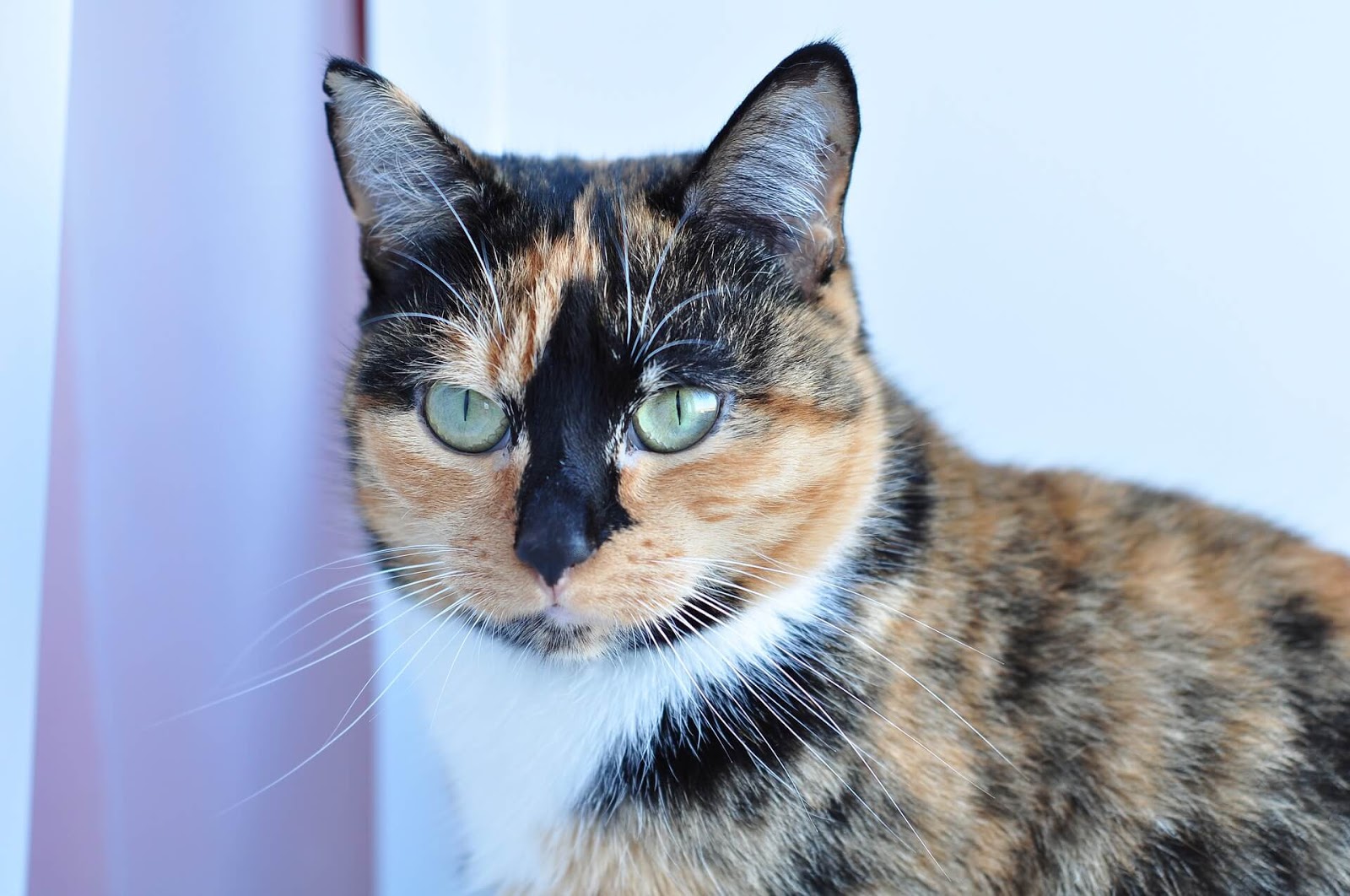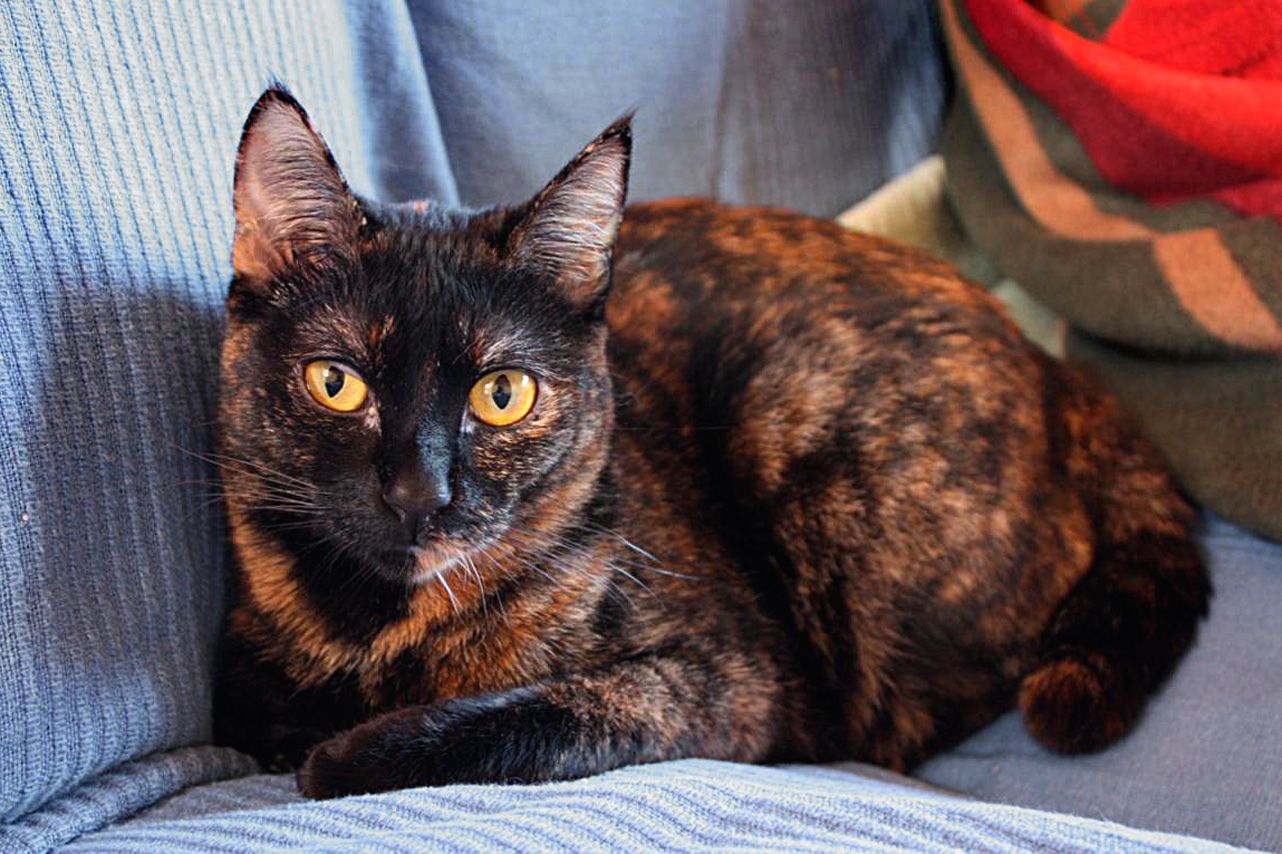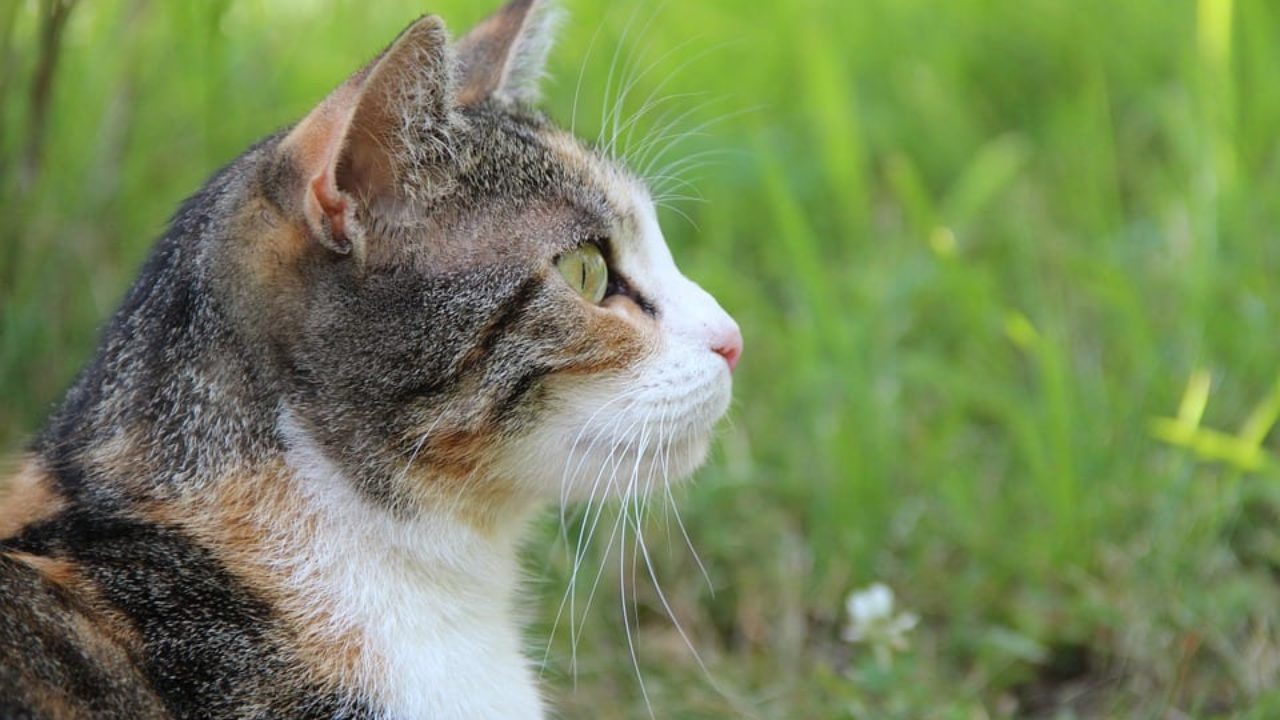Tortoiseshell cats are a type of feline known for their very colorful fur. His mantle is made up of black, orange and white areas, which are distributed throughout his body. This color distribution is totally unique and exceptional in each animal. Furthermore, this genetic phenomenon usually occurs among females of this species. In this article we will tell you what Carey Cats are like.

What are tortoiseshell cats?
Despite the perception that tortoiseshell cats are a breed of domestic feline, they are not. In fact, it is a complex genetic variation in cats, which causes a rather peculiar phenotypic manifestation. Tortoiseshell cats have a coat color pattern based on three colors; black, orange and white. However, sometimes there is a variable that includes chocolate, red and cream. This genetic variation can occur in recognized feline breeds, such as the Japanese Bobtail or the Cornish Rex.
This peculiarity of color will be different and unrepeatable in each cat, even if you try to reproduce them to obtain another similar specimen, the spots will be distributed differently. In addition, the reproduction process of this type of cat is a bit complicated, since the genetic result of the crossing that causes this phenomenon, mostly results in a female. This is because the orange color of their fur is linked to the X chromosome.
In other words, female cats have two XX chromosomes, which allow them to express the colors black and orange at the same time. On the other hand, male cats could only manifest one of these two, except that they carry a double X chromosome in their genes, in addition to the Y chromosome, thus causing Klinefelter syndrome (XXY). In cases where this happens and the tortoiseshell cat is male, they are usually infertile.
Tortoiseshell cats usually have a very unpredictable personality, but in general they are quite affectionate and friendly with their owners, becoming very territorial in the face of any invasion of their home. Likewise, they are observant, enthusiastic and restless, which is why they require a lot of physical activity and games to avoid stress. Moderate walks outside can be of great help for this problem.
Additionally, there are certain myths and legends about tortoiseshell cats, which ensure that they provide good luck. Used as a symbol to bring fortune to the home according to Celtic culture or to protect against evil spirits and storms according to Japanese sailors, these cats are surrounded by mysticism and spirituality. These beliefs are still valid today. In the United States, for example, they are still considered money cats.
Features
The most outstanding and observable characteristic of tortoiseshell cats is obviously their fur, since it presents the three basic color types in cats: orange, black and white. Despite this, sometimes there are certain variations of orange in red, cinnamon and cream; or some derivatives of black such as gray, blue or dark brown. Tortoiseshell cats have these three colors combined in species of spots. A peculiarity of these spots is that the largest and longest is located on your forehead.
Although the feline has various shades of orange or black, if it does not have all three colors on its coat at the same time, it cannot be considered a tortoiseshell cat. This is because in the animal world, there are other tricolor manifestations that are not precisely called hawksbills. This peculiar genetic phenomenon refers to the similarity of the fur of these cats with that of the shell of the large hawksbill turtles that inhabit the vast seas of the tropics.
Generally, the eyes of these types of cats are a dark orange or a shade of copper, instead, their muzzle and paw pads will be a black or pink color, or possibly a mixture of these two. The design of the tortoiseshell cats will never be the same in any specimen, even if it is tried through cloning. In fact, in 2001, a laboratory tried to clone a cat named Rainbow with the help of her genetic material and was unsuccessful. After all, her clone turned out totally different, this one was white and brindle despite having taken genetic samples from her tortoiseshell mother.
Genetics
Even if they become twins, two tortoiseshell cats will never have the same color distribution. All tortoiseshell cat litters are completely different because all of them, without exception, have a chromosomal alteration that makes them unique and special. However, it must be taken into account that tortoiseshell cats are not a particular variety, as this genetic variation can occur in any domestic feline regardless of its breed. The subject of genetics can be very extensive, however, there are certain key points that can explain this peculiar phenomenon.
When an egg and a sperm join during fertilization, the feline mother contributes 19 chromosomes with genetic information to the process, on the other hand, the father provides the other 19 chromosomes, resulting in a 38-chromosome genotype. Among the 19 chromosomes provided by the female is the X sex chromosome, and among the 19 provided by the male is another sex chromosome that can be either X or Y.
In other words, these sex chromosomes will play an important role in determining the sex of the offspring. The father's being the most influential, since he has the possibility of contributing both, the X or the Y. In cases where the X chromosome contributed by the father joins, in addition to the X chromosome contributed by the mother, she will have light a female. On the other hand, if the father contributes the Y sex chromosome, in addition to the X chromosome contributed by the mother, the result will be a male.
The gene that provides these cats with the orange and black color is only transmitted through the female chromosome, that is, since females (XX) have two X chromosomes, they have the possibility of having both colors in their fur, while males (XY) only have one X chromosome and therefore will only be black or orange. For this reason, it is essential that they have two X chromosomes to have both colors in their coat. The white color of tortoiseshell cats is rather a result of chance, not a genetic inheritance.
Despite this, although it is very rare, there are male hawksbills. But for this to happen, the cat must have a genetic code XXY, an anomaly known as Klinefelter Syndrome, which causes them to be infertile and, in the same way, causes their life expectancy to be much shorter than usual. These cats by having two X chromosomes, if they manage to have the color orange and black in their fur. According to statistics, one male tortoiseshell cat is born for every 3000 females.
Character
As mentioned above, tortoiseshell cats are not a proper breed, but because of a genetic alteration their fur is unrepeatable and quite characteristic. This alteration can occur in any domestic feline, which means that they are the same as other cats of their breed, in reality, the differences with the rest of their species can only be seen by us. For this reason, its character will depend on how the other cats of its breed normally behave.
However, in general, like any other common cat, they have a fairly calm and loving character if their environment allows it. Tortoiseshell cats are an ideal companion for any human being, because they are very affectionate with their owners. Despite this, they are also independent, sometimes they like to spend time alone without anyone bothering them and in open spaces to enjoy the outside.
Also, these cats love to play with balls or stuffed animals. They can be a very good playmate for the little ones in the house, as long as their limits are respected, avoiding any kind of confrontation between them. Similarly, remember that having a genetic alteration does not cause any type of illness in tortoiseshell cats, in addition to sterility in the case of males.
Types of Tricolor Cats
Despite the fact that these cats have unusual physical characteristics, all of them, without exception, can become our best friends, since they are extremely affectionate and loyal. However, there are certain patterns that allow the tricolor cat to be classified into several types. In the same way, the combinations and colors of these cats will always vary in each individual and can occur in any breed, so it is normal to see tricolor cats with long hair, short hair, skinny, chubby, etc.
tortoiseshell cats
These cats are characterized by the abundance of color in their fur. Its name is due to the similarity of its mantle with the shell of hawksbill turtles. In them, the colors black and orange are mixed asymmetrically throughout their body, in addition to a little white, but what can be observed is the predominance of dark tones. In addition to this, sometimes tortoiseshell cats can also be presented in diluted colors, such as cream or bluish gray. These diluted shades are a consequence of the D gene, which is responsible for minimizing the concentration of pigmentation.
calico cats
Calico cats or also known as Spanish cats, are mostly white, particularly in the area of the chest, belly, legs and chin. However, very well differentiated black and orange spots are also distributed throughout its fur. As in tortoiseshell cats, these cats can be found in paler versions; instead of having orange and black on its coat, it appears cream and bluish gray.
Tricolor Tabby Cats
Tricolor tabby cats are the less common version of this genetic alteration, they are a subdivision of calico and tortoiseshell cats. In this case, the animal will present a coat very similar to that of its relatives, the tigers. The three colors; black, orange and white, will manifest in patterns or stripes. Likewise, there are other even less frequent versions of tricolor cats: orange reaching shades that can be pink and black reaching grayish tones, as mentioned above. These latter felines are called tortoiseshell cats in the United States.
Myths and legends
There is a fantastic and enigmatic legend about the tortoiseshell expenses, in which it is tried to explain their presence among us, in addition in this certain magical attributes are attributed to them. Legend has it that a long time ago, being tired of only being able to observe how things were going on Earth and, without being able to do anything about it, the Sun decided that it wanted to be part of it. For this reason, he asked the Moon to do him a favor, this required the Moon to cover him in his absence so that human beings could not realize that the king star was missing in the sky.
The Moon accepted the proposal, and on a hot day in June she helped the Sun so that he could be absent from his job. As the sun withdrew, darkness reigned on earth. And eager to live life like any other living being, he decided to become an animal that was fascinating to him due to his agility and discretion, a black cat. A long time passed and the Sun intensely enjoyed those days, but the Moon, tired of covering it, withdrew without warning.
To prevent the sky from remaining without a celestial body, the Sun withdrew from the cat's body as soon as possible and left some gifts in its wake. From that moment on, the cat would carry with it thousands of light rays and golden colors, these would be visible throughout her mantle. In addition, the Sun, as a sign of gratitude for how wonderful and pleasant it was to live in her body, returned the favor to the cat by granting her a gift, this would take fortune and harmony to every place that came.
Since then, the daughters of that cat carry a legacy, the rays and flashes of the Sun on their fur and, in the same way, the temperament and wisdom of their mother. Her offspring would be what today we call tortoiseshell cats, their coat is dark in color with hundreds of red, orange, yellow and white rays. Carey cats have brought with them an aura of mysticism with their existence since time immemorial.
Therefore, for many years they have been attributed magical properties of good luck and have been a symbol of attraction of positive energies. In Japan, for example, they are highly valued animals since good fortune is attributed to them. In ancient times, Japanese sailors never left port without having a tortoiseshell cat on board, which they said ensured good weather during the voyage. On the other hand, in Ireland, tortoiseshell cats were used to ward off evil spirits.
However, today the reality is different, being out of the ordinary, many people find tortoiseshell cats ugly. Their distinctive coat is unattractive to potential owners in adoption centers, being very prone to being abandoned or orphaned from a young age. Beyond all the myths and legends that surround these cats, always keep in mind that when you choose this cat as your life partner, it will provide you with a lot of love and affection. In addition, the package will include that they are unique in their kind and no one will have a pet like yours.
We recommend these other interesting articles:



